How to Catch the Easter Bunny Activities
Keep your students engaged in learning this Easter with these free and editable How to Catch the Easter Bunny activities. If you’re reading “How to Catch the Easter Bunny” by Adam Wallace in your speech room this year, then make sure you check out these free Canva resources. Who doesn’t love Easter bunny activities?

What is “How to Catch the Easter Bunny” about?
Join the Easter Bunny on his wild adventures as he outsmarts traps left and right. This book has rhyming words, funny pictures, and a story that will keep your students hooked. If you don’t have the book, then play the video below for your students:
How to Catch the Easter Bunny Activities in Canva
Here are all the quick links to the activities in this blog post.
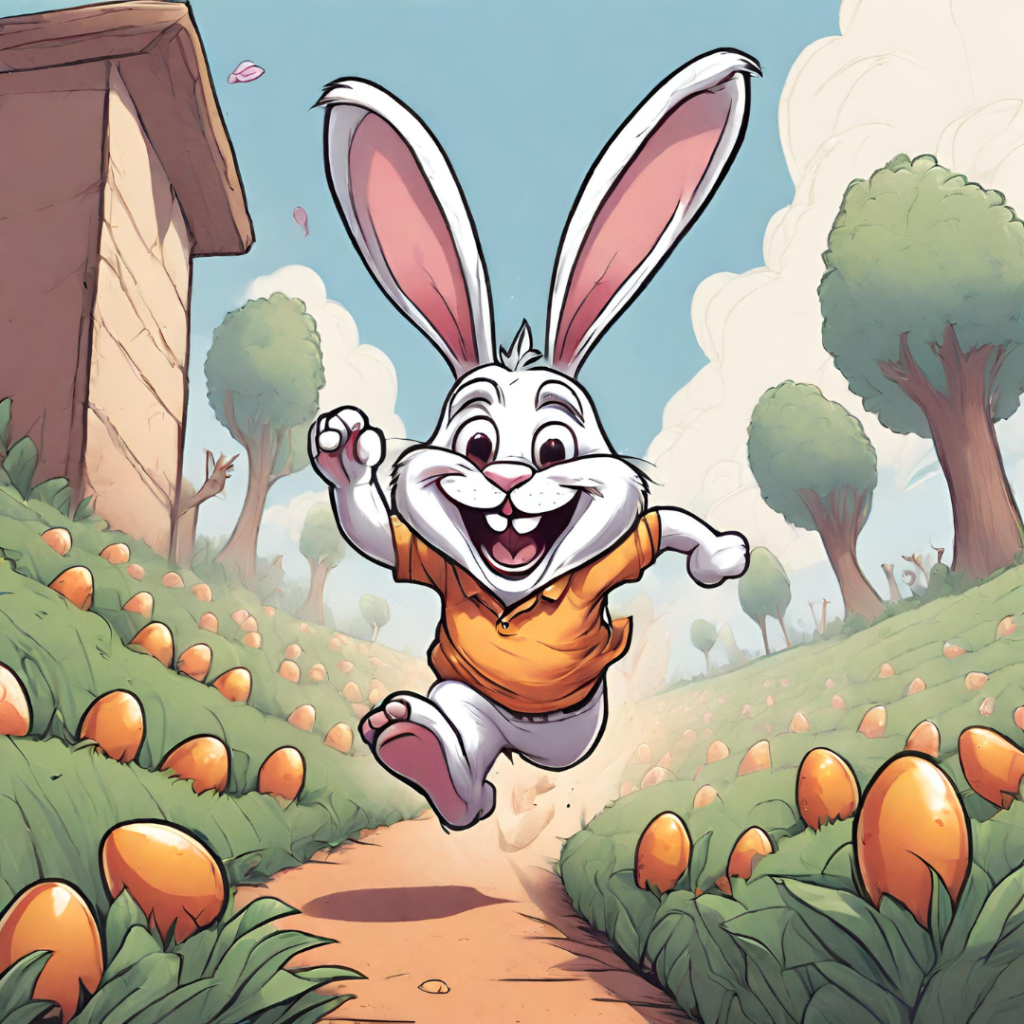
Easter Speech and Language Goals Targeted
By incorporating these Easter themed activities into speech therapy sessions, we can help preschool to 4th-grade students develop their language and communication skills in a fun and engaging way. These free Easter book companion activities will be a hit in your speech room.
This is my favorite story book for Easter because you can work on so many speech and language goals across subject areas, from creative writing to social studies and English language arts. Here are all the goals you can target with the activities in this blog post:
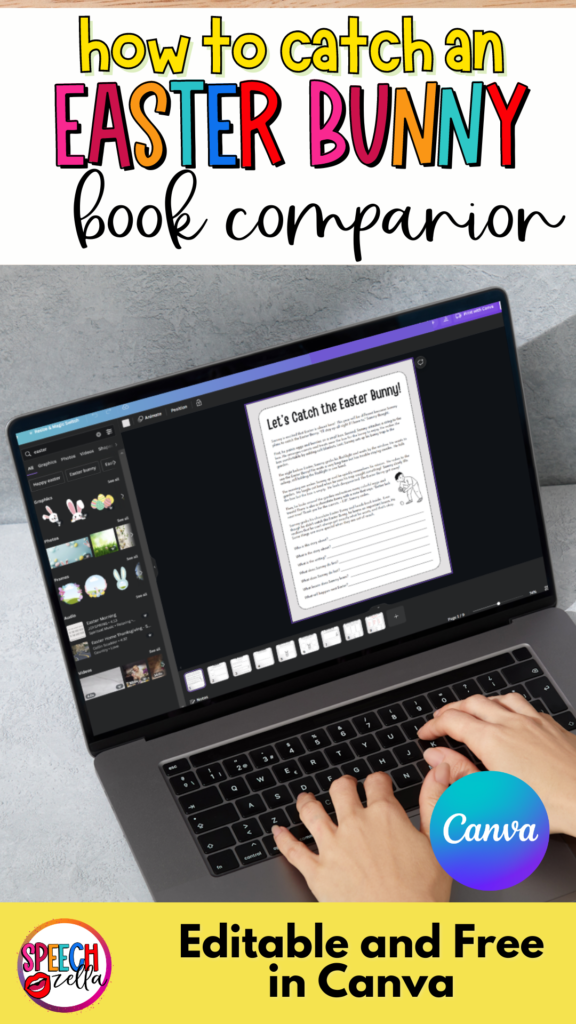
- Vocabulary: The vocabulary activities expose your students to vocabulary related to the holiday, such as “Easter bunny,” “Easter egg,” “basket,” “hunt,” and “spring.”
- Verbs: Students can learn to identify and express verbs with my Easter Bunny verbs adapted book.
- Problem-Solving Skills: Engage students in thinking about how the Easter Bunny avoids the traps.
- Prepositions: Use the included Easter prepositions flashcards to target spatial concepts
- Narrative Skills: The story of “How to Catch the Easter Bunny” provides a great way to target narrative skills. Children can retell the story in their own words, identify the main characters and events, and predict what will happen next.
If you want to know more about how to track your student's speech and language goals, then check out my blog post: Resources to Target Speech Therapy Goals and Objectives
Easter Bunny Activities for Canva SLPs
If you're on the hunt for fun educational activities that go hand in hand with the book “How to Catch the Easter Bunny,” then Canva's got you covered. This easy-to-use platform has eye-catching goodies that will take your teaching to the next level. Sign up for my exclusive freebie library to access all the Easter resources.
This Easter bunny read aloud lesson introduces students to the bunny’s clever antics to dodge snares at every turn.
It’s a perfect activity for spring resources and book studies, filled with rhymes, humor, and a plot that engages students from preschool to 4th grade.
Canva has different resource types to make up your Easter Bunny lesson plans.
From reading comprehension questions to graphic organizers and preposition flashcards, there's something for every learner.
Best of all, these activities have an easy setup with a free Canva for Education account. They are so easy to use – print and go!
If you have more questions, then check out my blog post about how to use Canva for Education.
Activity 1: How to Catch the Easter Bunny Worksheet Set
This packet of worksheets is the perfect activity to help students analyze the book’s story grammar elements. After reading the short passage, you can help your students improve their reading comprehension and recall by using the writing prompts included.
You can use this resource as a stand alone book study unit. However, you can use the Easter worksheets even if you don’t have the book. The first page includes an easy to read passage for young readers about a girl who wants to catch the Easter Bunny.
The rest of the Easter worksheets will help your students analyze the story's details, characters, and sequences.
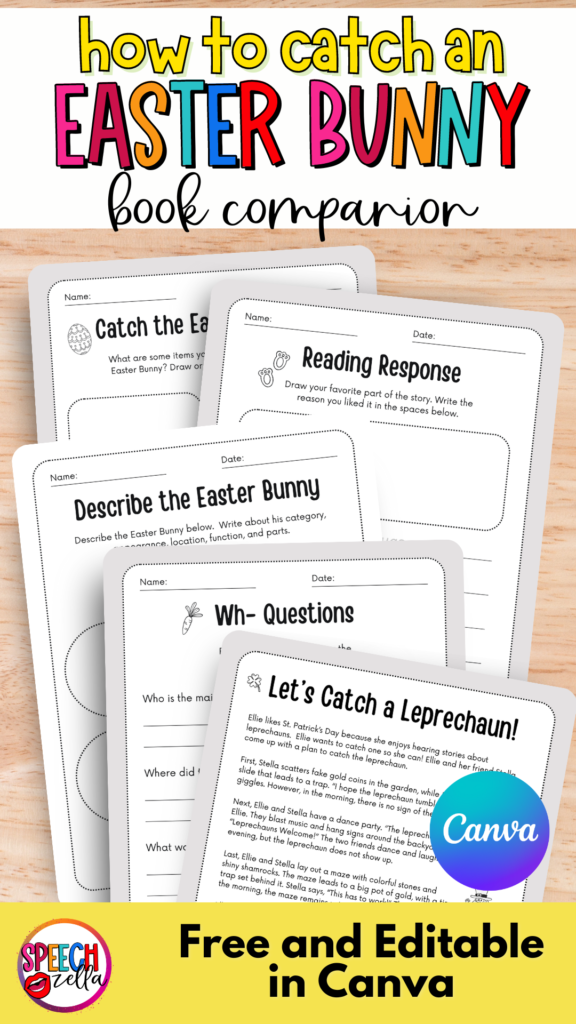
How to use these How to Catch the Easter Bunny Activities without the book:
- Introduce the activity by telling students that they are going to read a story about the Easter Bunny.
- Hand out copies of the reading passage to each student.
- Have students read the passage silently to themselves or read it in your small group.
- After students have finished reading, give out the reading comprehension worksheets.
What Easter Reading Worksheets are included?
- “Let’s Catch the Easter Bunny” reading passage.
- Wh- questions for story comprehension
- Story retell
- Reading response page (“What’s your favorite part of the story?”)
- Describe the Easter Bunny
- Story elements worksheet (e.g., characters, setting, problem)
- Design an Easter Bunny trap
- Easter Bunny parts of speech worksheet (sorting by noun/verb/adjective)
How to differentiate these Easter reading comprehension worksheets:
You have different options to level this resource for your students:
- For struggling students, provide them with a modified version of the reading passage that is easier to read. It’s so easy to edit the reading worksheet in Canva!
- Challenge advanced students to write their own story about the Easter Bunny.
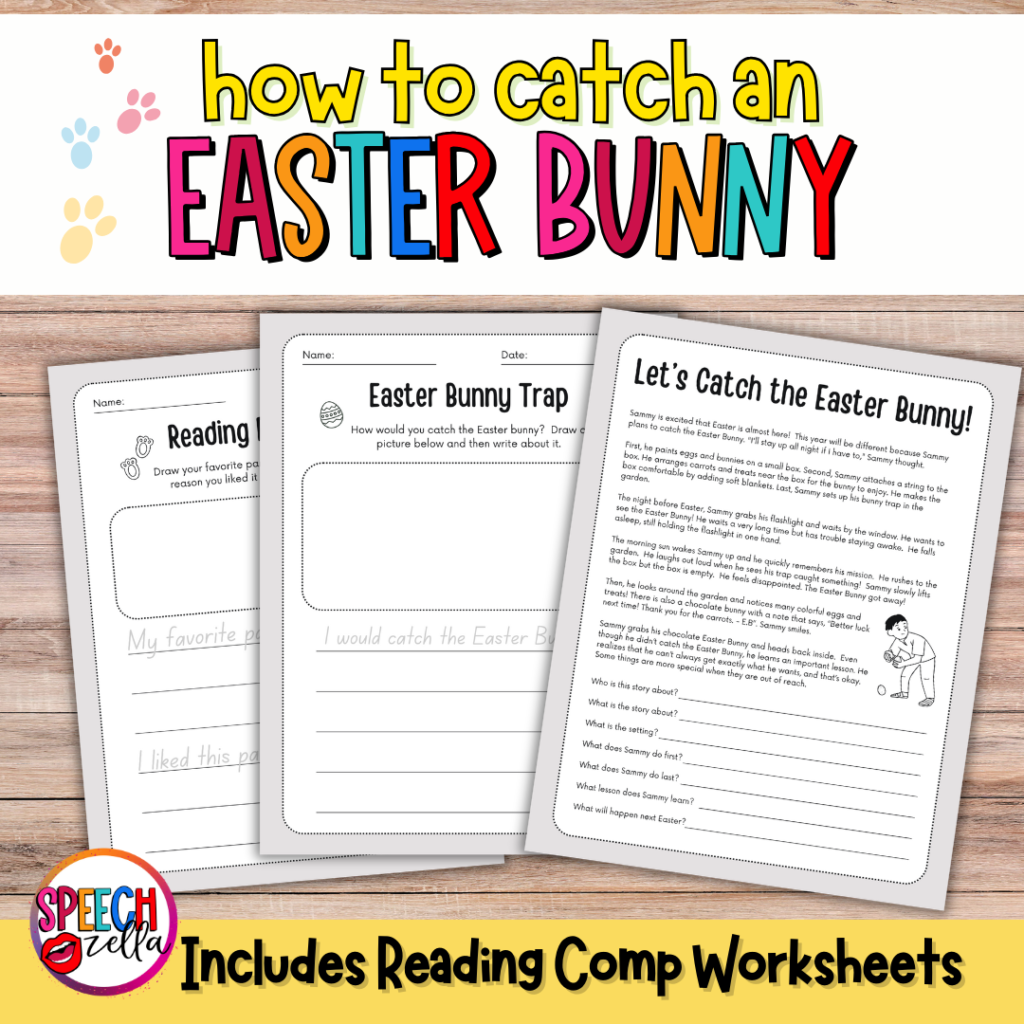
How Can I Become a Canva SLP?
It’s so easy to sign up for Canva for Education! Once you have a free account, you can access my freebie library. This freebie library includes tons of free and editable Easter and spring Canva templates you can use with your students.
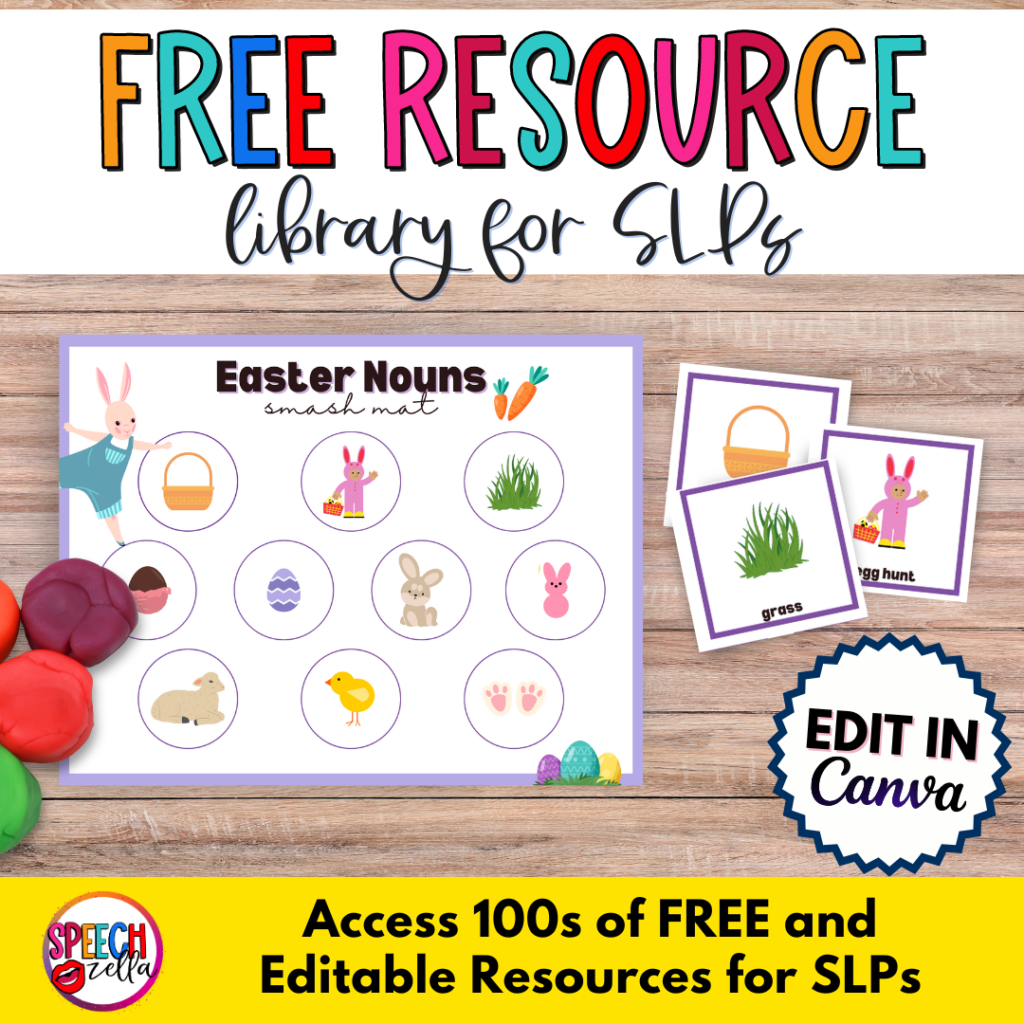
Click the link below to get access!
Activity 2: Easter Bunny Prepositions Flashcards
These Easter flashcards support students in their understanding and use of prepositions and spatial concepts. Each flashcard features a colorful illustration of the Easter Bunny and an Easter basket. The sentences on the flashcards are incomplete and leave a space for the students to fill in the correct prepositions.
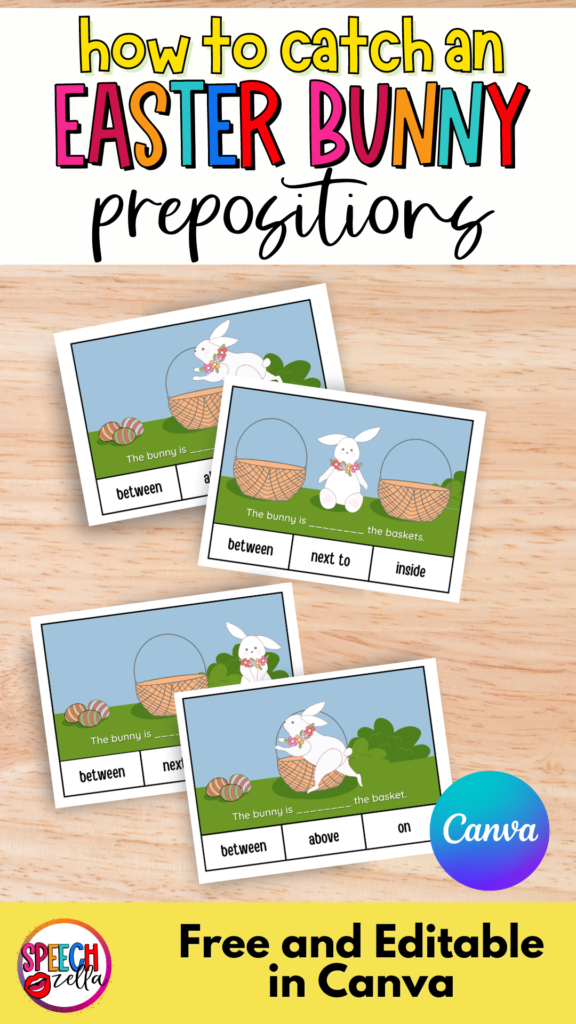
Here are a few examples of the flashcards included in the set (3 visual answer choices are included):
- The Easter Bunny is in the basket.
- The Easter Bunny is on the basket.
- The Easter Bunny is under the basket.
- The Easter Bunny is next to the basket.
- The Easter Bunny is behind the basket.
These flashcards are a fun way to assess your students' understanding of prepositions.
If you want to present these flashcards on the board, then change the format to a presentation and connect them to a projector.
Activity 3: How to Catch the Easter Bunny Writing Activity
Help your students improve their describing skills with this Easter Bunny writing activity. This activity includes a differentiated version to provide less or more scaffolding for students to describe the Easter Bunny. Both pages are great Easter writing activities for students with describing and defining goals.
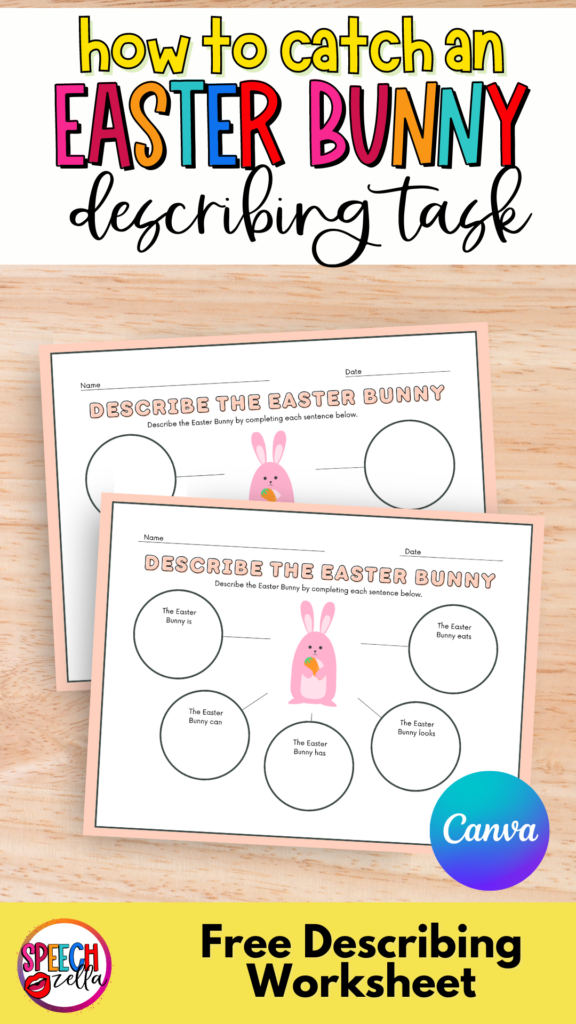
- The first worksheet is fill-in-the-blank and provides students with a sentence starter to help them describe the Easter Bunny. This helps students who need more support with describing and writing.
- The second worksheet is open-ended and allows students to use their own words to complete the Easter Bunny writing sheet. This is a more challenging writing task.
Both worksheets include pictures of the Easter Bunny to help students visualize what they are describing.
Who can use this Easter Worksheet?
- This worksheet is perfect for students in first grade through fourth grade.
- Anyone who needs to improve their describing or grammar skills.
- You can even use this worksheet on its own (without the book!)
Activity 4: Easter Nouns Smash Mat
Designed around the theme of Easter, this activity aims to reinforce Easter-themed vocabulary through tactile exploration and play.
How do I prepare this Easter Nouns Smash Mat?
- Print and laminate the included worksheet and cards.
- Gather playdough, Kinetic Sand, or Mad Matter to “smash” into the mat.
- Introduce the vocabulary flashcards to your students.
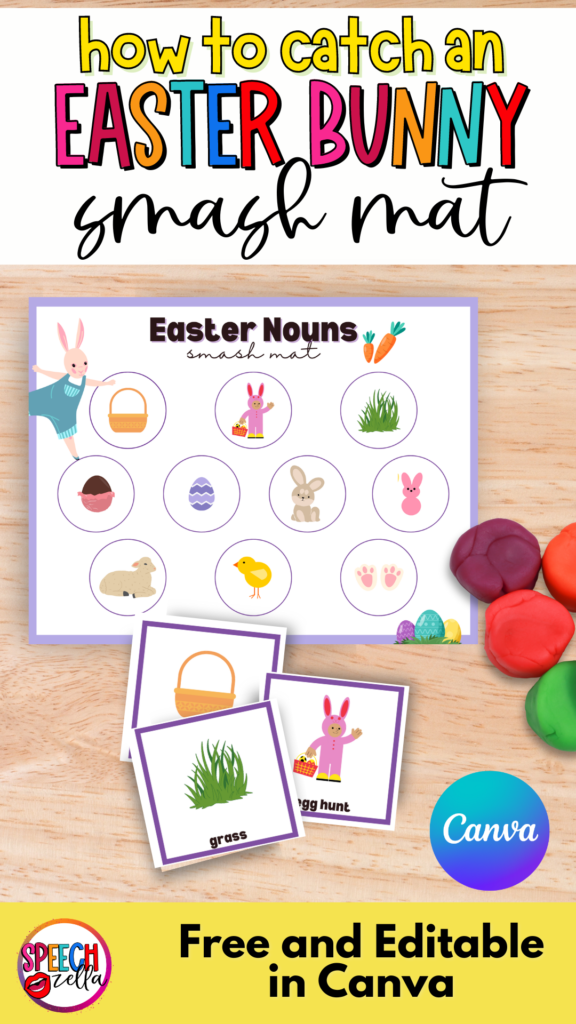
- Give each student a smash mat and some playdough (or other material you chose).
- Place the flashcards in a fun container (i.e., Easter hat, etc).
- Have your students pick out a flashcard.
- Then, they search their board to “smash” the Easter noun.
- Instruct them to “smash” the playdough over the object, covering it completely.
- You can even work on fine motor skills by including small objects for your students to manipulate.
By combining tactile learning with these fun pages, you can improve student engagement, sensory development, and language skills in young learners. It provides a fun way to reinforce Easter-related vocabulary while discussing parts of speech.
Activity 5: How to Catch the Easter Bunny Writing Craft
Students will cut out the Easter Bunny writing craft and write their own narrative: How to catch the Easter Bunny! This makes a really great Easter Bunny writing display or can be part of a spring bulletin board.
Here’s how to target your student’s goals with this bunny writing craft:
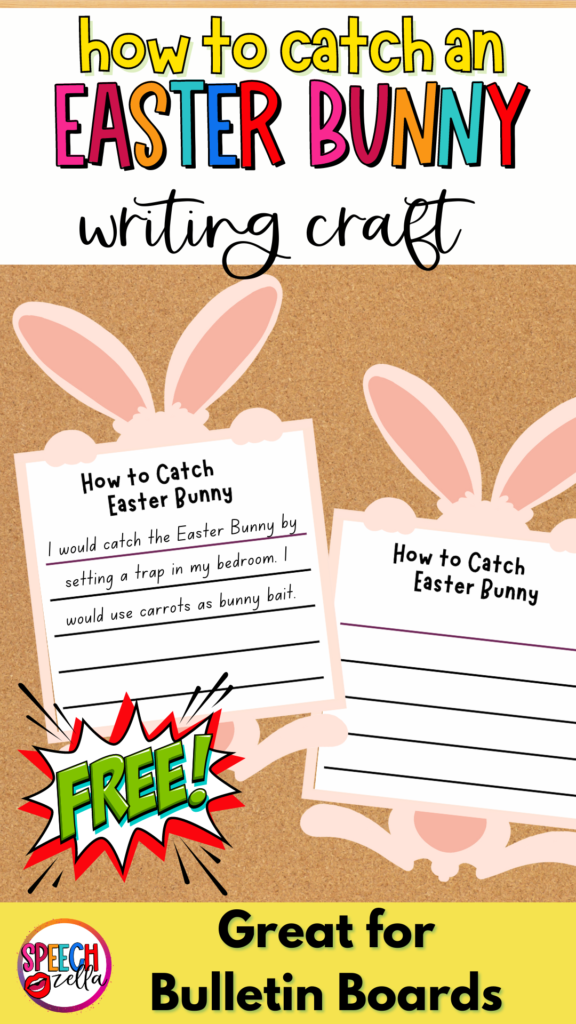
Narrative Skills / Procedural Writing:
- Ask students to choose a perspective – the Easter Bunny, a child, or a parent.
- Then, they describe the events leading up to the Easter Bunny's capture.
- Incorporate sensory details and dialogue to make the story more vivid and engaging.
- Encourage your students to use transitional words and phrases to connect ideas and create a smooth flow.
Creative Writing:
- Challenge students to design and describe creative traps or devices that could be used to catch the Easter Bunny.
- Encourage them to think outside the box and come up with unique ideas. What would they use as bunny bait?
- Have them discuss the pros and cons of different traps, considering factors like effectiveness, complexity, and possible consequences.
- They can even extend the activity and create their own bunny trap.
Sequencing:
- Your students will need to make sure they provide a clear sequence of events that lead to the capture of the Easter Bunny.
- They can break the story down into smaller steps to get them started writing.
- Encourage them to use critical thinking to come up with cause-and-effect relationships between different events.
Describing Skills:
- Prompt students to describe the personality and characteristics of the Easter Bunny.
- Encourage them to create a backstory for the bunny, explaining his motivations and behaviors.
- Discuss the role of the Easter Bunny in spreading joy and wonder during the Easter season.
This is a great way to work on your students' skills while making sure to increase student engagement!
Activity 6: Easter I Spy
This is a great and fun game that all your students will love. To use this Easter I Spy worksheet, students need to walk around their school or neighborhood and find Easter-related items. Once they have found an item, they use the sentence prompt to describe it to a partner.
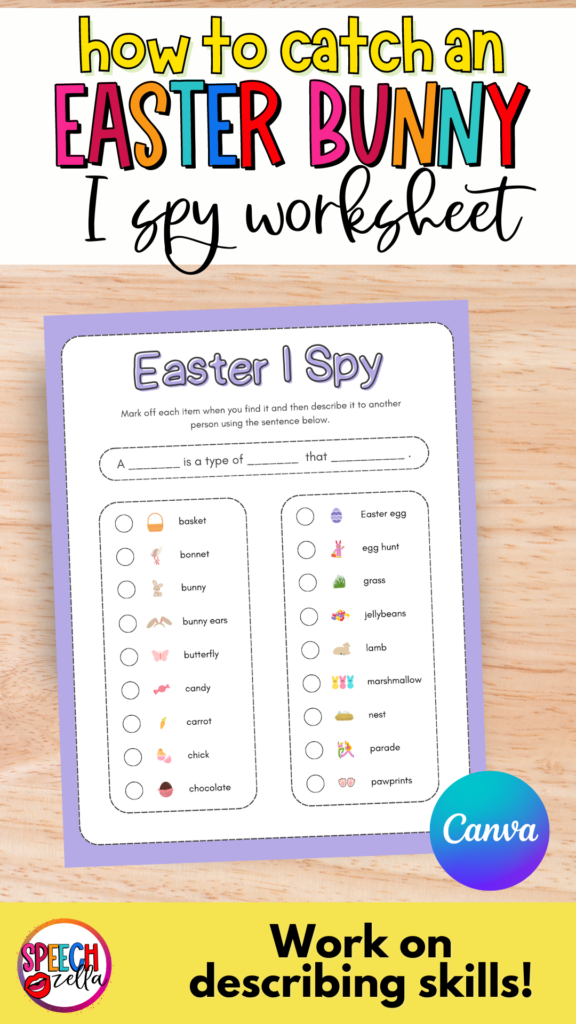
For example, they might say, “An Easter basket is a type of container that holds Easter eggs.”
This Easter I Spy worksheet can be used in several ways:
- Students can compete to see who can find the most Easter-related items.
- Or, they can play it as a cooperative game, where they work together to find all the items on the list.
- Hand out the worksheet right before spring break.
No matter how it is played, Easter I Spy is a great way for students to learn about Easter while having fun.
Activity 7: What is the Easter Bunny Doing? Verbs Adapted Book
This Easter adapted book has an interactive book format for students to learn about different verbs! The Easter Bunny is doing many silly things, and the students need to tell you what the bunny is doing in a complete sentence.
Students will read the sentence and identify the verb that correctly describes the bunny’s action. This activity helps students develop their vocabulary while learning verb tenses (with an Easter theme, of course!)
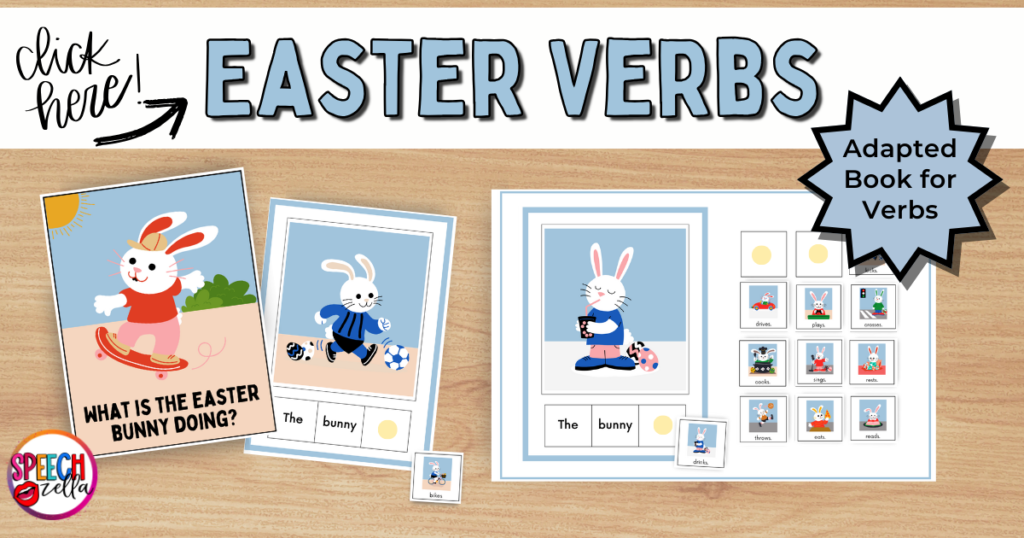
Extension Activities:
You can also pair this Easter verbs activity with these additional extension activities. That way, they can practice using verbs in different ways ( which helps to solidify their understanding).
- Verb Tense Change: Create a grid and have students list the verb tenses from present, to past, and then future.
- Identify the Verb: Students take turns identifying verbs in sentences and using them in their own sentences.
- Verb Charade: Give each student a piece of paper with a verb written on it. Get them to act out the verb without speaking, and see if their classmates can guess it correctly.
Activity 8: How to Catch the Easter Bunny Ideas: Bingo!
If your students are like mine, then they love bingo! Play this Easter bingo game in your speech room and work on inferencing, vocabulary, and describing skills.
All in all, there are 6 bingo boards and 16 Easter calling cards included. Each calling card has an Easter riddle and students guess the correct vocabulary word.
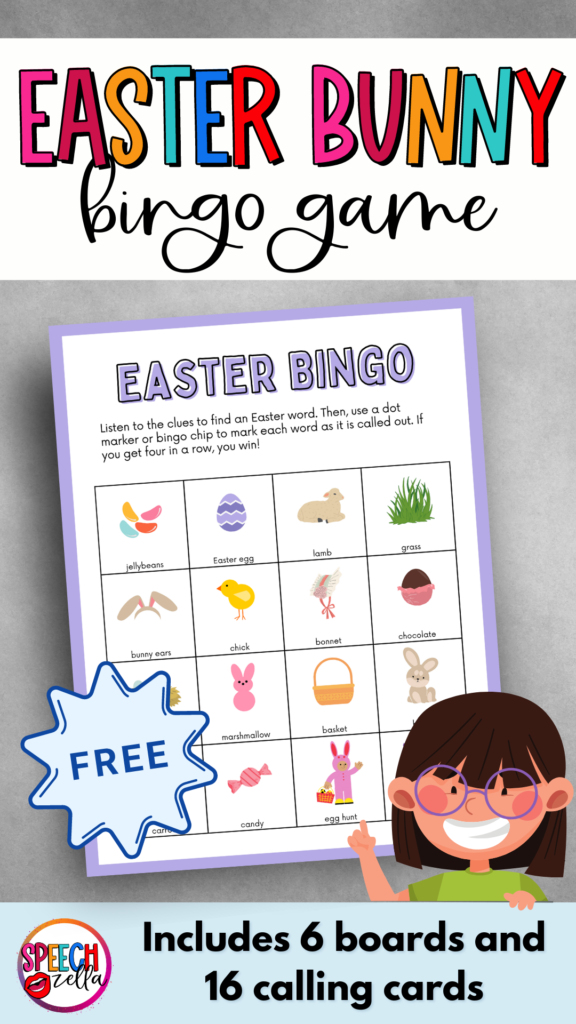
Easter Bingo Suggestions
- Different patterns: To make the game more challenging, players can try to mark off the words in a specific pattern (such as a diagonal line, a four-corner square, or a blackout (covering the entire card).
- Different bingo markers: For example, use bingo chips, magnetic bingo chips, erasers, or other fun manipulatives related to Easter.
Laminate for durability: Laminate the bingo boards to make them last longer. Then, the students can use dry erase markers to mark their boards.
Get Your Free Activities Today!
Check out the book “How to Catch the Easter Bunny” by Adam Wallace and the Canva activities that go with it. They're so fun for your little learners and a great way to sneak in some speech and language goals without even realizing it.
So, hop on this Easter bunny train, and let's make a difference in our students' lives.
Happy Easter, everyone!
